The “R” Ships
The long-standing company of Fearnely and Eger goes back to 1869 and was primarily involved in the tramp trade venturing into liner operations across the Atlantic and into the Pacific before the First World War. Between the wars the company continued to add to its fleet but lost nine ships during the Second World War.
Post war, Fearnley and Eger continued to thrive and went on to add bulk carriers and tankers to their substantial fleet. In 1972 the company began to diversify into different directions and in addition to their cargo and tanker ships took on partnerships relating to cruises ships, ferries as well as the oil business with supply ships and oil rigs.
In 1989 Renaissance Cruises was founded, the company building eight yacht like vessels aimed at the luxury market. It was believed that initially, Fearnley and Eger intended chartering the ships out, taking advantage of the large building subsidies available at the time from the Italian Government. The company however established a headquarters in Fort Lauderdale from where the vessels were marketed.
Originally eight Renaissance Class, vessels, were operated. The first ship was named Renaissance followed by Renaissance 2 through to Renaissance 8. They were small, intimate ships aimed at the luxury market and all were completed between 1989 and 1992.
The first four were built in Cantieri Navale Ferrari-Signani shipyards in La Specia and were 4,077gt with a length of 88.3m, and a beam of 15.3m. Two MAN-B & W 12V28 diesel engines gave them a speed of 15 knots.
The second batch of four ships was slightly larger at 4,200gt, had a length of 90.6m and a beam of 15.3m. Again, twin B & W diesel engines were installed giving a speed of 16 knots. Renaissance 5 to 8 was built in Nuovi Cantieri Apuania shipyard in Carrara, Italy. The first quartet carried 100 passengers, whilst the second group carried 114 in twin cabins.
The following is a brief history of the Renaissance Class vessels:-
Renaissance

Yard Number 43, entered service in 1989. Two years later she was chartered to Universal Cruise Lines of Singapore and subsequently renamed The Mercury. The vessel was laid up when Universal went bankrupt in 2002 and she then passed to Viking Lines, Malaysia, who continued to lay the vessel up until sold in 2004. The ship was used as a floating casino between Singapore and Malaysia as Leisure World I.

In March 2007 she was sold to the Dubai based Platinum Yacht Management, and is currently used as a yacht under the name of Dubawi (above).
IMO 8708646 International Call Sign Z6E3049
Renaissance Two

Yard Number 44 and entered service in 1990, remaining with the company until the larger R Class ships entered service.
In 1998 she was sold to Malaysian owner Robert Tan and renamed The Neptune. The ship was then chartered to Universal Cruises and was briefly renamed The Neptune 2. She was refitted in Singapore from her luxury configuration to a more basic vessel carrying twice the number of passengers as originally designed.
In 2005 Easycruises acquired her as EasyCruiseOne operating in the Western Mediterranean. This was a one-ship company started by the Easyjet founder Stelios Haji-Ioannou and intended to be a no frills cruise ship aimed at the younger market. The ship was painted in a similar bright orange livery to the Easyjet aircraft.

However the idea did not take off and in 2008 she passed to Platinum Yacht Management, Dubai and renamed Cruise One (above). She has been laid up at Jebel Ali, in Dubai for almost nine years, and appears to provide spares for her sister Dubawi (ex Renaissance).
IMO 8708658 International Call Sign 9HJU9
Renaissance Three
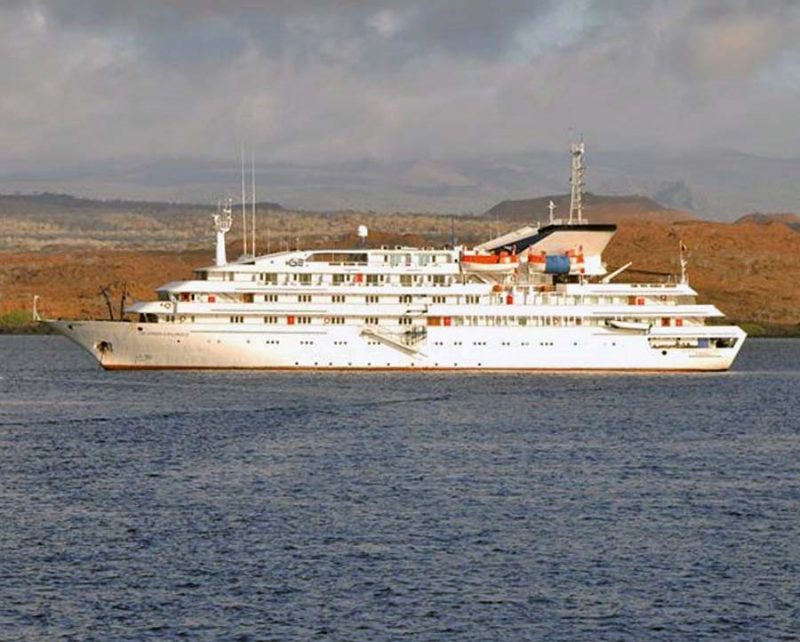
Yard Number 45 and entered service in 1990. Purchased by Canodros in 1997 and renamed Galapagos Explorer II (above).
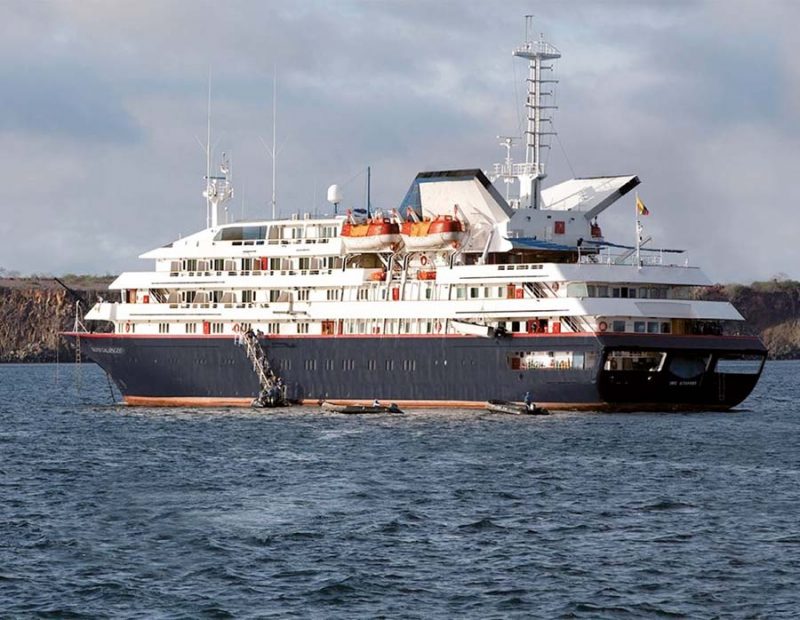
Silversea Cruises acquired the company in 2012 and she entered service in 2013 being renamed Silver Galapagos (above). The ship currently provides luxury cruises to the Galapagos Islands from Quito in Ecuador.
IMO 8708660 International Call Sign HC4403
Renaissance Four

Yard Number 46 and entered service in 1990. The ship was sold to Lindos Maritime in November 1996 being renamed Clelia II. The vessel was registered in the ownership of Goodwin Sands Marine and used as a private yacht. She was also operated by Travel Dynamics passing to Orion Cruises early in 2011 on a ten-year bare boat charter and renamed Orion II.

Orion Cruises terminated the charter after only one year and she reverted back to Travel Dynamics before being acquired by Grand Circle Cruise Line and renamed Corinthian (above).
IMO 8708672 International Call Sign 9HUT9
Renaissance Five

Yard Number 1144 and entered service in 1991. She was renamed Hanseatic Renaissance in 1992 and back to Renaissance Five in 1997. The same year the ship was sold to a company named Sun Viva and renamed Sun Viva. Star Cruises acquired the company in 2000 and she became Megastar Sagittarius.

Only remaining with that company for a short time she was sold to Cruise West and renamed Spirit of Oceanus (above).

Sold once again, in 2010, to the Clipper Group, who chartered her to Quark Expeditions and renamed Sea Spirit (above). She is currently sailing in Antarctic waters for Poseidon Arctic Voyages.
IMO 8802868 International Call Sign C6PJ8
Renaissance Six

Yard Number 1145 and entered service in 1991. Sold to Sun Cruises of Singapore in 1998 and renamed Sun Viva 2. In 2000 the company was taken over by Star Cruises and she was renamed Megastar Capricorn.
Hebridean Island Cruises bought the vessel in 2001 giving her a refit, which reduced the passenger numbers carried from 112 to 80. The ship was aimed at the ultra luxury market and renamed Hebridean Spirit (above).
The vessel was sold in April 2009 shortly before the company went into administration. She was renamed Sunrise and used as a charter yacht. Noble Caledonia bought the ship in 2012 and she now sails as Caledonian Sky.
IMO 8802870 International Call Sign C6202
Renaissance Seven

Yard Number 1146 and entered service in 1991. She became Regina Renaissance in 1992 reverting to her original name in 1998. The ship was sold in 2001 and renamed Renai I, becoming Sun in 2003 and in 2004 Island Sun owned by Mauritius Cruises.

In 2005 she was bought by the Danish Clipper Group and renamed Corinthian II (above). After a refit in Greece the vessel was chartered to Travel Dynamics for service in the Mediterranean.

She passed back to the Clipper Group and renamed Sea Explorer (above) undertaking voyages for Quark Expeditions.
In January 2012 the vessel was chartered by Noble Caledonia and renamed Hebridean Sky.
IMO 8802882 International Call Sign C6BG2
Renaissance Eight

Yard Number 1147 and entered service in 1992. The vessel remained with Renaissance Cruises until the firm filed for bankruptcy in 2001. She was renamed Renai II and laid up.

The ship was renamed Sky in 2003 and Island Sky in 2004 when Mauritius Island Cruises acquired her. When that company went out of business, the same year, she was bought by the Danish Clipper Group, to be immediately chartered by Noble Caledonia.
In 2009 Island Sky (above) was purchased outright by them.
IMO 8802894 International Call Sign C6TQ2
The building of these ships was heavily subsidised by the Italian government to maintain employment at the shipyards. The ships were completed for $20 million each, about half of their actual cost.
The first Gulf War hit the parent company hard, and the ambitious plans involving the cruise ships, and other cargo carrying tonnage had stretched the company’s finances severely and Fearnley and Eger filed for bankruptcy on the 16th September 1991.
Following the liquation of Fearnley and Eger, Renaissance Cruises was taken over by Navigazione Alta Italia S.p.A, formed my the Cameli Group (Italy), Jorgen Jahre Shipping AS (Norway) and US Tour operators including Edward Rudner, who had also founded the Alamo Car Rental Company.
However in 1996, following the success of the smaller vessels in the luxury market an ambitious plan was made to order, eight 30,000gt cruise ships from the French yard, Chantiers de l’Atlantique, St. Nazaire. The shipyard, in effect, set up a production line in constructing these almost identical vessels.
Beginning late 1996 the majority of the Renaissance Class yacht like vessels began to be either sold or charted out so that the company could introduce the new 30,000gt R Class ships. Before the firm went bankrupt in 2001 only two of the smaller ships were left in the company, Renaissance Seven and Renaissance Eight.
All but one of the Renaissance Class vessels are still sailing, Renaissance Two being laid up in Dubai. The ships operate world wide, three operated for the luxury market by Noble Caledonia.
The company angered travel agents by capping the commission received on bookings. Consequently a boycott was placed on the company, which still continued to develop and in 2000 carried 220,000 guests. These were excellent results for a company mainly carrying out is own reservations, however often at a dangerously low discounted rate.
In April 2001 Malvern Marine acquired a stake in the firm injecting $300 million into its capital. The new ownership removed the commission cap paid to travel agents, who once again began to provide the company with passenger bookings. Without the travel agent bookings is was estimated that the company lost $95 million from sales of $580 million.
Details Of The R Class Ships
Gross Tonnage: 30,277
Deadweight: 2,700
Length: 180.45m Beam 25.46m
Draught: 5.92m (11 decks)
Engines:
- 4 Watsila 12 V 32 Diesel engines via
- electric drive producing 13500kw
- Two 750 kw bow thrusters
- Two screws giving a service speed of 18
- knots (Max 20k.)
Stabilizers: Two folding fins, extended 4.125m with an area of 9.9m2.
The eight ships are each fitted with 2 lifeboats, 4 tenders and 2 rescue boats. Each ship cost £150 million to build.
Although when built the vessels were practically identical and could carry a maximum of 824 passengers, as time progressed variations occurred after improvements were made, and passenger numbers varied.
As an example Regatta (ex R Two) was extensively refurbished in 2014, and although it was not possible to alter the size of her cabins by moving partitions, the following is an example of the different cabin types and sizes.
A total of 342 cabins, with 232 being fitted with a balcony.
- Owner’s Suites (6) 90m2. (Two each situated on decks 6, 7 and 8 at the stern of the ship, with views to the side and stern.
- Vista Suites (4) 73m2. (Two each situated on decks 6 and 7 at the very fore part of the superstructure with views to the side and ahead.)
- Penthouse Suites (52) 30m2
- Balcony Cabins 20m2
- Outside View and interior cabins 14.8m2 to 15.3m2.
Two of the Azamara ships (Journey and Quest) had two additional lido suites added following modernisation early in 2016.
All the ships were named with the prefix R followed by One to Eight. A naming system more akin to First World War Royal Navy submarines or Second World War German motor launches or minesweepers, but rather unimaginative for cruise ships.
As they entered service, R one and R Two were allocated to the Mediterranean. R Three and R Four to French Polynesia, R Five, Europe, R Six to the Baltic, R Seven to the Caribbean and R Eight to South East Asia.
However with the terrorist attack on the United States of 9th September 2001 there were mass cancellations by passengers and on the 25th September 2001 the company, which was already in poor financial condition, ceased trading.
On that date all the ships at sea were ordered back to port and ‘arrested’ with the possibility that creditors would seize belongings of passengers left in cabins as assets. However, this did not happen, and passengers left their respective ships and returned home.
Apart from R Three and R Four, in the Pacific, all the ships were initially laid up at Gibraltar and some later to Marseilles, whereas the two ships operating in French Polynesia were laid up locally.
Following the collapse of Renaissance Cruses, Cruiseinvest Management S.A. was formed by the creditors, including the builders and the French Bank Credit Agricole. At an auction held in Gibraltar and Tilbury, the company was successful in bidding for the acquisition of six of the eight ships. These included R One, R Two, R Five, R Six, R Seven and R Eight.
Later American Marine Advisors (AMA) a New York based investment bank, dedicated specifically to the maritime industry, was hired to eventually sell off the ships to recoup some of the cost.
Technical management of the vessels was entrusted to Martinoli S.A.M. of Monaco, an international ship management company and technical project consultancy group with experience in the cruise and tanker shipping industry. This company also managed a number of the ships including R Five, R Six, R Seven and R Eight on short-term charters to other companies.
Cruiseinvest Management SA was registered in the Marshall Islands as a company with an office in Paris to oversee the management of the newly purchased ships.
When the ships were sold there was a $100 million loss on the vessels sold to P & O/Princess which bought for $75 million dollars each and the newly formed Oceania Cruises paid $130 million for their newly acquired ships, substantially less than the new build cost.
The following is the history and current status of each of the R Class ships:
R One
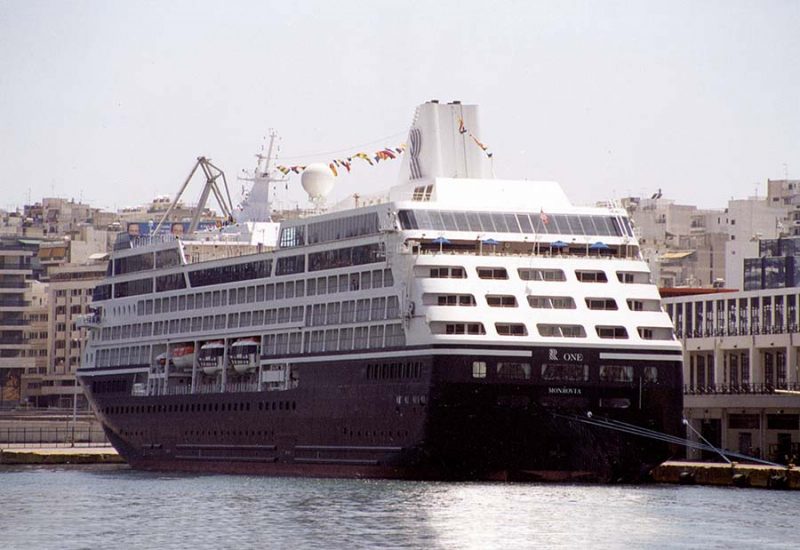
R One was the first of the class of eight ships to be built. Yard No H31, her keel was laid on the 26th June 1997 and she was launched on 24th January 1998 entering service on the 25th June 1998, being allocated to cruises in the Mediterranean. Following the collapse of the company on the 25th September 2001 she was laid up in Gibraltar until bought by Cruiseinvest and then chartered to Oceania Cruises entering their service in 2004.

She was renamed Insignia (2) above and christened in Monte Carlo by Virginia Watters, wife of the founding chairman of Oceania Cruises, Joe Watters.

In 2006 Oceania purchased the ship, but in the spring of 2012 chartered her to Hapag Lloyd for two years, and during this time she was renamed Columbus 2 (above).
In April 2014 the ship underwent a major refurbishment in Marseilles, before being returned to the Oceania fleet on the 31st May 2014 reverting to her original Oceania name.
On the 7th December 2014 Insignia left Miami on a 10 day cruise to the Caribbean, and on the 11th December whilst in St. Lucia a major fire broke out in the engine room of the ship. Two Korean contract workers and one Filipino crewmember lost their lives. The cruise was terminated and 656 passengers were flown home. Following the completion of minor repairs the Insignia was towed to San Juan in Puerto Rico where full repairs were carried out.
Insignia returned to service in March 2015 to start a world cruise from Singapore, which had been due to commence in Miami on the 10th January 2015 for 180 days. Leaving Singapore on the 10th March 2015 she began her amended voyage, the previous leg of which had been to sail from Cape Town, South Africa on the 15th February 2015 for 35 days.
For the remainder of 2015 Insignia cruised world wide, including the United States/Canada, Atlantic Coast, Pacific, Mediterranean and Middle East.
Insignia undertakes world cruises commencing in January each year, her next one is planned to sail from New York on the 11th January 2019.
IMO 9156462 International Call Sign V7DM2
R Two


R Two (Yard No I31) was laid down on the 7th January 1998 and launched on the 22nd May 1998 being delivered to her owners on the 24th November 1998, commencing her cruising career in the Mediterranean. However after Renaissance went bankrupt on the 25th September 2001 the vessel was arrested and laid up at Gibraltar before being sold to Cruiseinvest and moved to Marseille, France where the vessel continued to remain idle.
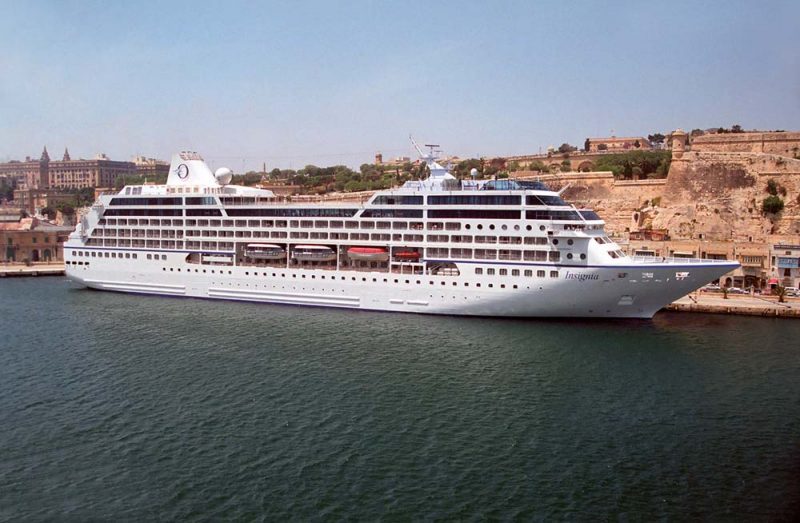
In October 2002 R Two was chartered to Oceania Cruises and given a $10 million refit. The ship was purchased out right in 2006. Upon entering service with Oceania she was renamed Insignia (1) above. Between 19th April 2003 and 14th June 2003 the vessel was chartered to the French travel agency TMR who marketed the ship as the Vaisseau Renaissance, although her registered name remained unchanged.

On the 15th June 2003 the ship returned to Oceania, but was renamed Regatta (above), the name Insignia having passed to her sister R One which entered service the following year.
In May 2014 Regatta completed a $40 million refit at Vancouver when all cabins received major upgrades including new mattresses, carpets, furniture and bedding. A new specialist coffee shop was installed, similar to that already on-board the larger Oceania vessels, Marina and Riviera, plus more tables for two in the main dining room. Externally a miniature golf course, shuffleboard court and other deck games became additional features.
During 2018 the vessel is primarily cruising in the Pacific including Alaska.
IMO 9156474 International Call Sign V7DM3
R Three

R Three (Yard No N31) was laid down on the 19th December 1997 and launched on the 12th March 1999 entering service with Renaissance Cruises on 28th July 1999. She was owned by a group of French investors who leased the ship to that company. The French Government also subsidised the ship with the proviso that she operated from the French Polynesian Islands. Upon entering service, together with R Four, she was based in French Polynesia.
Along with the other vessels of the Renaissance fleet creditors seized her in September 2001 and the French Polynesian Government, who retained an interest in the ship, repossessed her. This happened at the port of Uturoa on the island of Raiatea in French Polynesia and the ship was laid up.
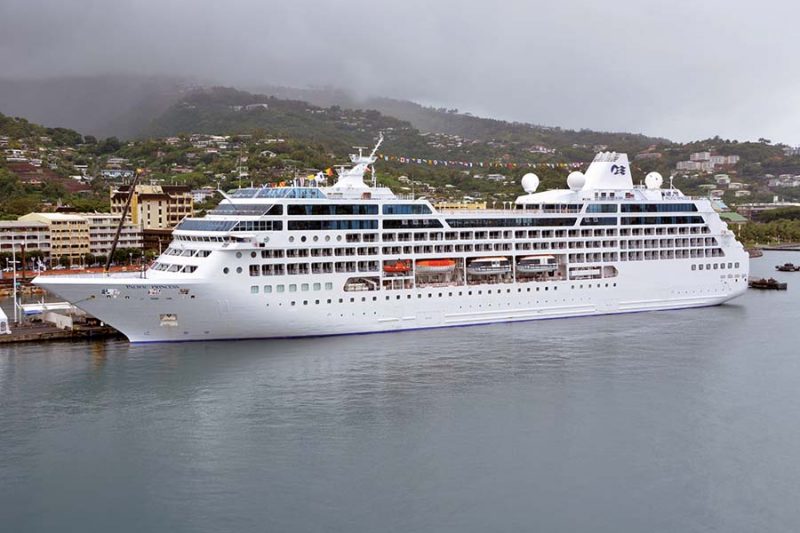
Princess Cruises acquired the ship in and renamed her Pacific Princess (above) at Sydney on the 8th December 2002. After two years of service the vessel was purchased outright. Pacific Princess is currently the smallest in the Princess Cruises fleet being less than half the size of the next largest vessels.
The accommodation of Pacific Princess enables her to carry 688 passengers in 344 cabins of 8 different types. The Standard and Outside View cabins are somewhat compact when compared with the larger vessels in the fleet. In addition to the Standard Cabins, there are 52 Mini Suites, and 10 Owners’ Suites offering a higher degree of size and luxury. Pacific Princess has a crew of 373, making a crew to passenger radio of 1:8.
For the majority of 2018 the ship is operating in Europe including the Mediterranean, however in 2019 she cruises to Africa, South America and the Panama Canal.
IMO 9187887 International Call Sign ZCDS3
R Four
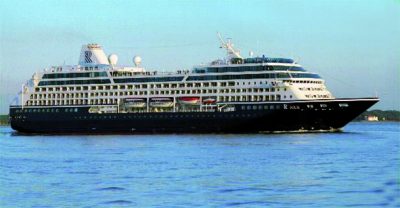
R Four (Yard No. O31) was laid down on the 19th December 1997 and launched on 12th May 1999 entering service on 22nd October 1999 for Renaissance Cruises. This was under the same agreement as her sister R Three, being owned by a group of French investors and subsidised by the French Government.
The ship was leased back to Renaissance Cruises her operations being restricted to the Pacific/Polynesia under the terms of the government subsidy.
Following the collapse of Renaissance Cruises in September 2001 the vessel was arrested at Uturoa and re possessed by the French Polynesian Government. The ship was then laid up, before being chartered by Princess Cruises in 2002 for two years, following which she was purchased outright.

The ship was renamed Tahitian Princess (above), sponsored by Madame Tonita Flosse, the First Lady of French Polynesia and entered service withPrincess Cruises on Christmas Eve in 2002.
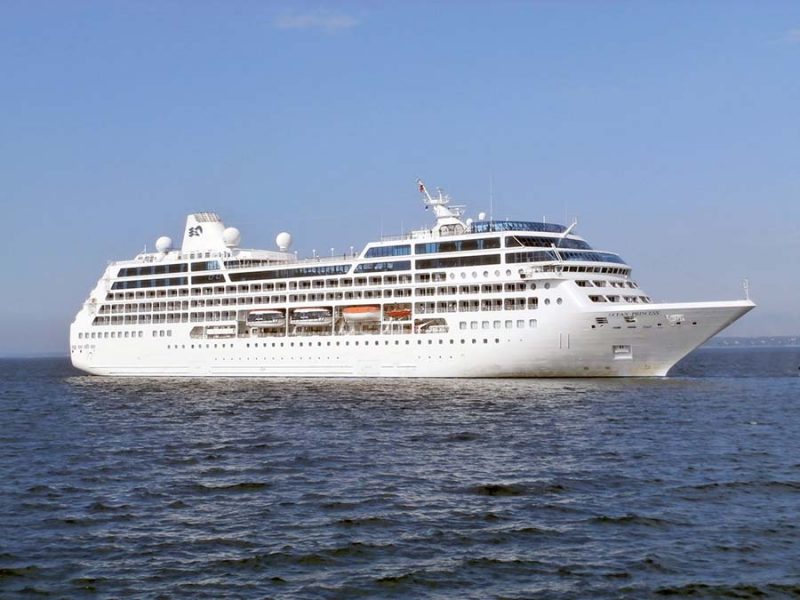
In November 2009 the ship was renamed Ocean Princess (above) to reflect a more global theme, the vessel undergoing a major refurbishment in October 2012.

On the 25th November 2014 it was announced that Ocean Princess was to be sold to Oceania Cruises, and renamed Sirena (above), thereby joining her three R Class sisters Insignia, Nautica and Regatta, in that fleet.
She underwent a 35 day $40 million dollar refit in Marseille before commencing her inaugural cruise on the 27th April 2016 from Barcelona in Spain on a 14 day voyage around the Mediterranean to Venice.
During 2018 her cruises are planned to operate in the Mediterranean.
IMO 9187899 International Call Sign ZCDS4
R Five

R Five (yard No. P31) was laid down on the 22.3.99 and launched on 31st July 1999 and entered service on 27th January 2000 for Renaissance Cruises, sailing on voyages based in the Mediterranean.

After Renaissance went out of business in 2001, R Five was laid up at Gibraltar, sold to Cruiseinvest in December 2001 and moved to Marseille. From June 2002 the vessel was chartered to the Spanish based Pullmantur Cruises being marketed under the name Blue Dream (above), although she still carried the name R Five on her stern. The logo Pullmantur Cruises was painted in large white letters on both sides of her black hull. Blue Dream (R Five) was managed by the Cruiseinvest associate company Martinoli S.A.M., Monaco.

The ship was aimed at the Spanish market, but in the European winter season she operated out of Brazil with Pullmantur’s associate travel company CVC.
R Five left Pullmantur Cruises in 2004 and re-entered service in November 2005 after being chartered by Oceania Cruises and renamed Nautica (above). Miami philanthropist and civic leader Fana Holtz christened her in Istanbul. The vessel was purchased outright the following year in 2006.
On 30th November 2008 Nautica was involved in an incident when sailing from Safaga, Egypt to Salalah, Oman when at about 8.30am two Somalia pirate skiffs attacked her.
Her master, Captain Jurica Brajcic took evasive action and Nautica was able to outrun her attackers. Although the ship was fired at eight times no one on board was injured, and the vessel proceeded to her next port of call.
Nautica underwent a major refurbishment in 2014 in Marseilles.
The ship is now operating cruises in Europe for both 2018 and 2019 including around the British Isles.
IMO 9200938 International Call Sign V7DM4
R Six

R Six was laid down on the 20th September 1999 and launched on the 17th January 2000 (Yard No Q31) entering service on the 24th June 2000.

Following the collapse of Renaissance Cruises the ship was laid up at Gibraltar, until purchased by Cruiseinvest. She was subsequently chartered to Pullmantur Cruises and operated under the name ‘Blue Star Cruises’, although not officially renamed she still carried R Six on her stern, but Blue Star on the bow. The logo Pullmantur Cruises was also painted in large white letters along the two sides of her black hull (above).

As with her sister (R Five/Blue Dream), she was managed by Martinoli S.A.M. (Monaco).
In 2005 R Six was purchased outright by Pullmantur and renamed Blue Dream above to add to the confusion with her sister R Five, spending her first winter operating for the associated Brazilian tour operator CVC.
On the 27th July 2005 Blue Dream struck the quay whilst maneuvering to berth at Rhodes, Greece. The vessel sustained damage on the port side, however no injuries or pollution were reported. Following repairs the vessel returned to service on the 30th July 2005.
Pullmantur was acquired by Royal Caribbean in 2006 and it was intended to rename her Celebrity Journey, to be marketed under the company’s Celebrity Expedition brand in exchange for the Zenith.

However before the name change took place she was transferred to the newly formed prestige subsidiary Azamara Club Cruises in 2007 and renamed Azamara Journey (above).
She was last refurbished in 2012 costing $10 million and a blue hull replaced the earlier white one. Azamara Journey underwent another refurbishment in the Bahamas in January 2016 prior to her 2016 cruise programme. This started in Costa Rica, sailing through the Panama Canal and ending in Miami. Thereafter she cruised around the Caribbean before crossing the Atlantic in April sailing from Miami to Nice in France. She continued on Mediterranean voyages until October sailing from Rome to Dubai spending Christmas 2016 in Singapore.
Following a 105 day world cruise commencing in March 2018 the ship will cruise in the Mediterranean during the summer of 2018 before moving to the Caribbean later in the year.
Currently Azamara Journey carries a crew of 408 and 686 passengers, at double occupancy in cabins.
IMO 9200940 International Call Sign 9HOB8
R Seven

R Seven was laid down on the 19th November 1999 by her builders (Yard No X31) and launched on the 24th March 2000 being accepted into service on the 27th September 2000. However following the collapse of Renaissance Cruises she was laid up at Gibraltar.

Acquired by Cruiseinvest the vessel was chartered to the German based company Delphin Seereisen in 2003 and renamed Delphin Renaissance (above).

In 2006 she was purchased by Pullmantur, Spain and renamed Blue Moon (above), sistership Blue Dream (ex R Five).

However the following year, in October 2007, she was transferred to Azamara Cruises and renamed Azamara Quest (above).
On 30th March 2012 about 8.19pm the ship experienced a fire in an engine room in waters south of the Philippines.
Azamara Quest was carrying a total of 1,001 people on board and had sailed from Manila the previous day en route to Sandakan, Malaysia. Although the fire was quickly extinguished five of the crew, but none of the passengers, were injured.
The ship was extensively refurbished at the end of 2012, and underwent a further $10 million refurbishment at Singapore in April 2016. This included modernizing the décor in the public spaces, major upgrades to cabins and suites, plus the addition of two new Spa Suites and an expansion of the pool grille.
Her 2016 cruise season started in Australia, she then moved on to Singapore, Dubai following which she sailed to European waters through May to August. The vessel then crossed the Atlantic to the east coast of the United States, where she cruised until a New Year’s voyage commencing in Puerto Rico on Boxing Day and ended at Miami on the 4th January 2017.
The ship will cruise in the Caribbean early in 2018 before moving to Europe, the Mediterranean, and later in the year to the Pacific.
IMO 9210218 International Call Sign 9H0M8
R Eight

R Eight Yard No. Z31 was laid down on the 10th April 2000 and launched on the 16th September 2000 entering service on the 16th February 2001. Following the collapse of Renaissance Cruises she was laid up at Gibraltar before being moved to Marseille being acquired by Cruiseinvest.

During 2002 it was announced that Swan Hellenic was to take the ship on a seven year charter and after a refit entered service in April 2003 as the Minerva II (above), being managed by Martinoli S.A.M of Monaco. On the 7th April 2007 Minerva II completed her final voyage with Swan Hellenic and was transferred to the parent company, Carnival Corporation and incorporated into the Princess fleet, commencing her first voyage as Royal Princess (above next column) on the 19th April 2007.

A fire broke out, on the 18th June 2009 in an engine room whilst on a 12 day Holy Land cruise, the ship having just sailed from Port Said in Egypt. Soon after the initial blaze started a more serious fire broke out, completely disabling the vessel, forcing her to return to the port for a full assessment.
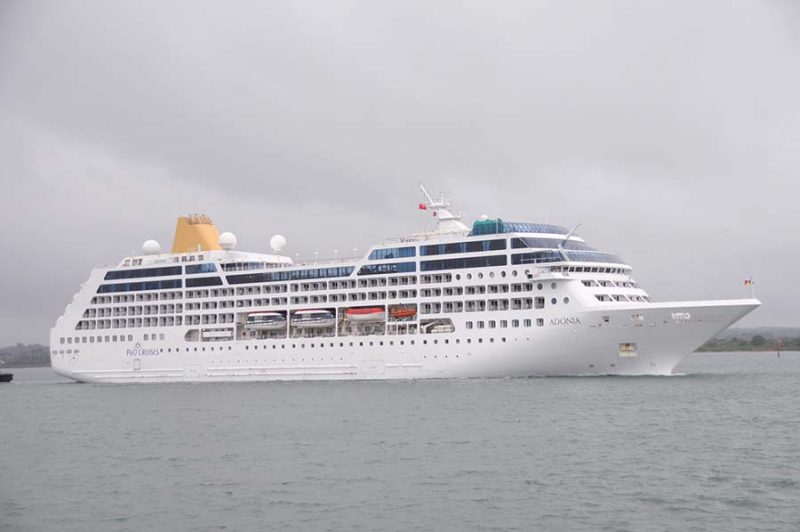
On the 9th December 2009 it was announced that Royal Princess was to transfer to P. & O. Cruises as Adonia (above) on 21st May 2011, after being christened by Dame Shirley Bassey.
In June 2015 the Carnival Corporation unveiled a new brand called ‘Fathom’. This was billed as ‘Social Impact Travel’ taking passengers on 7 day journeys from Miami to the Dominican Republic, starting in April 2016. Trips involved volunteer activities with established organisation on the ground.
Excursions included activities such as windsurfing or hiking, plus the opportunity to cultivate cocoa plants, make chocolate with a women’s co-operative, work with education to teach English skills and help to build water filters.
The ship spent two days each travelling to and from Amber Cove a new port that the Carnival Corporation has developed on the nations north east coast.
However this venture did not prove a success and after one season the ship returned to the P. & O. fleet continuing to undertake cruises, mainly around Europe.

On the 26th September 2017 P. & O. announced that Adonia had been sold to Azamara Cruises, the last cruise taking place will leave from Barbados on the 23rd February 2018. She was renamed Azamara Pursuit (above) joining her two other R Class sisters, Azamara Journey and Azamara Quest. The refit to prepare her for her new owners commenced in March 2018 at the Grand Bahamas Shipyard. The maiden Azamara voyage is titled ‘Fjords from Southampton’. The ship is due to sail from Southampton on a 12 night cruise to Norway on 1st August. The following eleven cruises are all from Southampton until she arrives in Barcelona late September 2018 when the passengers are flown back to the UK. The next cruise from Barcelona terminates in Athens, with the following cruises around the Greek Islands.
IMO 9210220 International Call Sign ZCDV2
All eight R Class ships are still in service operating with the higher end of the cruise market.
The experienced cruise industry veterans, Joe Watters and Frank Del Rio, formed Oceania Cruises in 2002, the latter had been vice president of Renaissance Cruises until it went out of business. It was suggested at the time of forming Oceania Cruises it was just another name for Renaissance.
On the 2nd September 2014 the Norwegian Cruise Line purchased Prestige Cruise Holdings the parent company of Oceania Cruises and Regent Seven Seas Cruises for $3.025 billion. However both companies remain independently run with the advantage of having the greater bulk buying power of the much larger organisation.
On the 25th November 2014 Norwegian Cruise Line announced that it had purchased Ocean Princess ex R Four to be operated within the Oceania fleet. The vessel was renamed Sirena, and following a 35 day $40 million refit at Marseilles, started her first Oceania cruise at the end of April 2016. The last Princess cruise, being in January 2016 off the east coast of South America and Caribbean.
Thus, from April 2016, Oceania Cruises operated four R Class ships (R’s One, Two, Four and Five) plus the two larger ships built specifically for the company, entering service in 2011/12 (Riviera and Marina).
Although Norwegian Cruise line has introduced a number of newbuild ships to the fleet recently, and has further vessels on order, the decision was made to buy a second hand vessel of the R Class, rather then to build a new ship of a similar size to the larger Riviera and Marina. Regent Seven Seas Cruises, another acquisition at the same time as Oceania, already had a new ship, Seven Seas Explorer, on order from Fincantieri, in Italy. This vessel was laid down on the 21st January 2015 and seven months after the takeover she commenced cruising in July 2016.
Azamara Club Cruises, a subsidiary of Celebrity Cruises now operates three R Class ships (R Six, Seven and Eight) aimed at a similar luxury cruise/passenger market as Oceania.
Azamara Pursuit starts her career with her new owners in August 2018 with European and Greek Island cruises.
It is interesting to note that the highly successful Viking River Cruises, which operates river cruises throughout Europe and further afield has branched out into the ocean cruise market. Their ships are of a similar size to the two larger ships Riviera and Marina in the Oceania fleet, being aimed at the same luxury market and passengers.
The one remaining independent R Class ship, Pacific Princess is owned by the Carnival Corporation, and operated by Princess Cruises. With the sale of Adonia by P. & O. (Carnival) to Azamara it remains to be seen how long Pacific Princess remains a Carnival ship or if either Oceania or Azamara will buy her? However she is scheduled to undertake a World Cruise in January 2019 and has cruises advertised up to the end of that year.
Although the original concept inaugurated by Renaissance Cruises failed as a result of poor financial management and the terrorist attack of 9/11 the idea of small ship luxury cruising has been successfully perpetuated, especially by Noble Caledonia, Oceania Cruises and Azamara Club Cruises, utilising the original Renaissance and R Class ships.
Out of the sixteen original Renaissance Cruise vessels, only one of the smaller units, Renaissance Two, is not being used in the luxury cruise or yacht charter market, and their popularity appears to continue to grow. All the vessels have stood the test of time and the owning companies continue to invest in them as well their purchase or charter as they come on to the market. None have been sold off, other than to the higher end market and the size and design of both the smaller and larger vessels continues to make them a profitable investment.


Comments
Sorry, comments are closed for this item